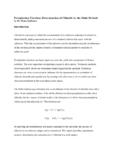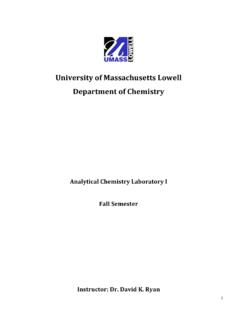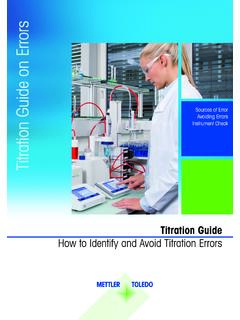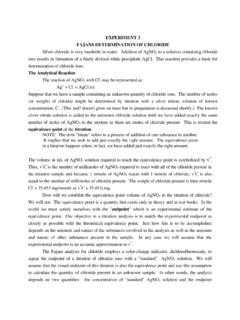Transcription of Precipitation Titration: Determination of Chloride by the ...
1 Precipitation Titration: Determination of Chloride by the Mohr Methodby Dr. Deniz KorkmazIntroductionTitration is a process by which the concentration of an unknown substance in solution isdetermined by adding measured amounts of a standard solution that reacts with theunknown. Then the concentration of the unknown can be calculated using the stoichiometryof the reaction and the number of moles of standard solution needed to reach the socalled end titrations are based upon reactions that yield ionic compounds of limitedsolubility. The most important precipitating reagent is silver nitrate. Titrimetric methodsbased upon silver nitrate are sometimes termed argentometric methods. Potassiumchromate can serve as an end point indicator for the argentometric Determination ofchloride, bromide and cyanide ions by reacting with silver ions to form a brick-red silverchromate precipitate in the equivalence point Mohr method uses chromate ions as an indicator in the titration of Chloride ions with asilver nitrate standard solution.
2 After all the Chloride has been precipitated as white silverchloride, the first excess of titrant results in the formation of a silver chromate precipitate,which signals the end point (1). The reactions are: Ag + Cl AgCl(s)+-424 2Ag + CrO AgCrO(s)+2-By knowing the stoichiometry and moles consumed at the end point, the amount ofchloride in an unknown sample can be determined. This report describes experimentsaimed at determining the concentration of Chloride in a solid and MethodsEquipment and Reagents:3324 The solid reagents used in this experiment were NaCl, CaCO, NaHCO, KCrO and3 AgNO. The equipment used is listed below:A buret Transfer pipette 25 mL and pipette pumpErlenmeyer flasks 250 mL DesiccatorVolumetric flask 500 mL Amber bottleGraduated cylinder 100 mL Wash bottleMethods:24 Preparation of 5% K2 CrO4(indicator): g of KCrO was dissolved in 20 mL ofdistilled of standard AgNO solution: g of AgNO was weighed out, transferred toa 500 mL volumetric flask and made up to volume with distilled water.
3 The resultingsolution was approximately M. This solution was standardized against NaCl was dried overnight and cooled to room temperature. gportions of NaCl were weighed into Erlenmeyer flasks and dissolved in about 100 mL of3distilled water. In order to adjust the pH of the solutions, small quantities of NaHCO24were added until effervescence ceased. About 2 mL of KCrO was added and the224solution was titrated to the first permanent appearance of red of Cl- in solid sample: The unknown was dried at 110 C for 1 hour andocooled in a desiccator. Individual samples were weighed into 250-mL Erlenmeyer flasks3and dissolved in about 100 mL of distilled water. Small quantities of NaHCO were24added until effervescence ceased. About 2 mL of KCrO was introduced and the solution224was titrated to the first permanent appearance of red AgCrO.
4 An indicator blank was3determined by suspending a small amount of Chloride free CaCO in 100 mL of distilled27water containing 2 mL of and Interpretation of Data3 Standardization of AgNO33 Replicate Sample, g NaCl Volume of AgNO used, mL Concentration of AgNO, M Blank - 1 2 3 for Replicate 1 of standardization :Molecular mass of NaCl = g/mole3mmoles of AgNO = = mmoles3 Molarity of AgNO == M (Reagent volume corrected for blank)3 Molarity of AgNO = = MDetermination of Chloride in Unknown3 Replicate Weight of Unknown, g Volume of AgNO, mL % (w/w) Cl in unknown 1 2 3 for Replicate 1 of unknown.
5 Atomic mass of Cl = g/mole-33mmoles of Cl = MAgNO x VAgNO = ( ) mL = mmoles- mass of Cl = mmoles = mg- %Cl (replicate 1) = x 100 = %Cl in unknown = well known Mohr s method in which alkaline or alkaline earth chlorides react withsilver nitrate in the presence of a few drops of potassium chromate solution as indicator isa simple, direct and accurate method for Chloride this experiment, the amount of Chloride in an unknown sample was determined byMohr titration. The titration was carried out at a pH between 7 and 10 because chromateion is the conjugate base of the weak chromic acid (2, 3).
6 Therefore, when the pH is lowerthan 7, chromate ion is protonated and the chromic acid form predominates in thesolution. Consequently, in more acidic solutions the chromate ion concentration is toolow to produce the precipitate at the equivalence point. If the pH is above 10, brownishsilver hydroxide forms and masks the end point. A suitable pH was achieved bysaturating the analyte solution with sodium hydrogen the solubilities of silver Chloride and silver chromate depend on temperature, alltirations were carried out at about the same temperature. Good stirring during the additionof the silver nitrate is also required for a sharp and reproducible end point; otherwise,silver chromate that forms locally before the endpoint can become occluded in the silverchloride precipitate instead of silver nitrate solution and the silver Chloride precipitates formed were protectedfrom light at all times because silver Chloride decomposes according to:2 AgCl Ag(s) + Cl (g)The silver ion concentration at chemical equivalence in the titration of Chloride withsilver ions is given by:[Ag] = = = x 10 M+-5 The chromate ion concentration required to initiate formation of silver chromate underthis condition can be computed from the solubility product constant for silver chromate.
7 4[CrO] == = 10M2--3 In principle, an amount of chromate to give this concentration should be added, in orderto develop the red precipitate after the equivalence point. However, a chromate ionconcentration of x 10-3 M imparts such an intense yellow color to the solution thatformation of the red silver chromate is not readily detected. Thus, lower concentrations ofchromate ion are generally used. An excess of silver nitrate is therefore required beforeprecipitation begins. An additional excess of the reagent must also be added to produceenough silver chromate to be seen over the heavy white precipitate of silver two factors create a positive systematic error in the Mohr method that becomessignificant in magnitude at reagent concentrations lower than about M. A correctionfor this error was made by a blank Determination .
8 In a blank Determination , all steps ofthe analysis are performed in the absence of the analyte. In this experiment, blank wasdetermined by titrating a solution of a small amount of Chloride free calcium carbonateand indicator potassium chromate with standard silver nitrate solution. Calciumcarbonate was used to imitate the white silver Chloride precipitate. Reagent volumes werecorrected for blank in the Skoog D. A.; West D. M.; Holler F. J. Fundamentals of Analytical Chemistry, 7thEdition, Thomson Learning, Inc, USA, Sheen and Kahler H. L. Effects of Ions on Mohr Method for ChlorideDetermination, Ind. Eng. Chem. Anal. Ed.; 1938; 10(11); Kraemer E. O. and Stamm A. J. Mohr s Method for the Determination of Silver andHalogens in other than Neutral Solutions, J. Am. Chem. Soc.
9 ; 1924; 46(12); 2707-2709.











